Large-Scale Modeling of Absorbing Aerosols and Their Semi-Direct Effects
Abstract
1. Introduction
2. Methods
2.1. Model Description
2.2. Model Setup
3. Results
3.1. Absorbing Aerosol Distribution
3.2. Radiative Effects
3.2.1. Impacts on Atmospheric Heating Rates
3.2.2. Top of Atmosphere Radiative Effects
3.3. Regional Effects
4. Conclusions
Author Contributions
Funding
Acknowledgments
Conflicts of Interest
References
- Heald, C.L.; Ridley, D.A.; Kroll, J.H.; Barrett, S.R.H.; Cady-Pereira, K.E.; Alvarado, M.J.; Holmes, C.D. Contrasting the direct radiative effect and direct radiative forcing of aerosols. Atmos. Chem. Phys. 2014, 14, 5513–5527. [Google Scholar] [CrossRef]
- Intergovernmental Panel on Climate Change (IPCC). Climate Change 2013: The Physical Science Basis. Contribution of Working Group I to the Fifth Assessment Report of the Intergovernmental Panel on Climate Change; Cambridge University Press: Cambridge, UK; New York, NY, USA, 2013; p. 1535. [Google Scholar]
- Myhre, G.; Samset, B.H.; Schulz, M.; Balkanski, Y.; Bauer, S.; Berntsen, T.K.; Bian, H.; Bellouin, N.; Chin, M.; Diehl, T.; et al. Radiative forcing of the direct aerosol effect from aerocom phase ii simulations. Atmos. Chem. Phys. 2013, 13, 1853–1877. [Google Scholar] [CrossRef]
- Bond, T.C.; Doherty, S.J.; Fahey, D.W.; Forster, P.M.; Berntsen, T.; De Angelo, B.J.; Flanner, M.G.; Ghan, S.; Kärcher, B.; Koch, D.; et al. Bounding the role of black carbon in the climate system: A scientific assessment. J. Geophys. Res. Atmos. 2013, 118, 5380–5552. [Google Scholar] [CrossRef]
- Lamarque, J.F.; Bond, T.C.; Eyring, V.; Granier, C.; Heil, A.; Klimont, Z.; Lee, D.; Liousse, C.; Mieville, A.; Owen, B.; et al. Historical (1850–2000) gridded anthropogenic and biomass burning emissions of reactive gases and aerosols: Methodology and application. Atmos. Chem. Phys. 2010, 10, 7017–7039. [Google Scholar] [CrossRef]
- Tesche, M.; Ansmann, A.; Müller, D.; Althausen, D.; Engelmann, R.; Freudenthaler, V.; Groß, S. Vertically resolved separation of dust and smoke over cape verde using multiwavelength raman and polarization lidars during saharan mineral dust experiment 2008. J. Geophys. Res. Atmos. 2009, 114. [Google Scholar] [CrossRef]
- Huang, J.; Guo, J.; Wang, F.; Liu, Z.; Jeong, M.J.; Yu, H.; Zhang, Z. Calipso inferred most probable heights of global dust and smoke layers. J. Geophys. Res. Atmos. 2015, 120, 5085–5100. [Google Scholar] [CrossRef]
- Ginoux, P.; Prospero, J.M.; Gill, T.E.; Hsu, N.C.; Zhao, M. Global-scale attribution of anthropogenic and natural dust sources and their emission rates based on modis deep blue aerosol products. Rev. Geophys. 2012, 50. [Google Scholar] [CrossRef]
- Kippertz, P.; Stuut, J.B.W. Introduction to ‘mineral dust—A key player in the earth system’. In Mineral Dust: A Key Player in the Earth System Dordrecht; Knippertz, P., Ed.; Springer Science + Business Media: Berlin, Germany, 2014; pp. 1–14. [Google Scholar]
- Highwood, E.J.; Ryder, C.L. Radiative effects of dust. In Mineral Dust: A Key Player in the Earth System; Knippertz, P., Stuut, J.-B.W., Eds.; Springer: Dordrecht, The Netherlands, 2014; pp. 267–286. [Google Scholar]
- Lacis, A.A.; Mishchenko, M.I. Climate forcing, climate sensitivity, and climate response: A radiative modeling perspective on atmospheric aerosols. In Aerosol Forcing of Climate: Report of the Dahlem Workshop on Aerosol Forcing of Climate; Charlson, R.J., Heintzenberg, J., Eds.; John Wiley Sons: Chichester, UK; New York, NY, USA, 1994. [Google Scholar]
- Wendisch, M.; Hellmuth, O.; Ansmann, A.; Heintzenberg, J.; Engelmann, R.; Althausen, D.; Eichler, H.; Müller, D.; Hu, M.; Zhang, Y.; et al. Radiative and dynamic effects of absorbing aerosol particles over the Pearl River Delta, China. Atmos. Environ. 2008, 42, 6405–6416. [Google Scholar] [CrossRef]
- Ming, Y.; Ramaswamy, V. Nonlinear climate and hydrological responses to aerosol effects. J. Clim. 2009, 22, 1329–1339. [Google Scholar] [CrossRef]
- Koch, D.; Del Genio, A.D. Black carbon semi-direct effects on cloud cover: Review and synthesis. Atmos. Chem. Phys. 2010, 10, 7685–7696. [Google Scholar] [CrossRef]
- Hansen, J.E.; Sato, M.; Ruedy, R. Radiative forcing and climate response. J. Geophys. Res. Atmos. 1997, 102, 6831–6864. [Google Scholar] [CrossRef]
- Huang, J.; Wang, T.; Wang, W.; Li, Z.; Yan, H. Climate effects of dust aerosols over east asian arid and semiarid regions. J. Geophys. Res. Atmos. 2014, 119, 11398–11416. [Google Scholar] [CrossRef]
- Perlwitz, J.; Miller, R.L. Cloud cover increase with increasing aerosol absorptivity: A counterexample to the conventional semidirect aerosol effect. J. Geophys. Res. Atmos. 2010, 115. [Google Scholar] [CrossRef]
- Wolke, R.; Schröder, W.; Schrödner, R.; Renner, E. Influence of grid resolution and meteorological forcing on simulated european air quality: A sensitivity study with the modeling system cosmo-muscat. Atmos. Environ. 2012, 53, 110–130. [Google Scholar] [CrossRef]
- Meier, J.; Tegen, I.; Heinold, B.; Wolke, R. Direct and semi-direct radiative effects of absorbing aerosols in Europe: Results from a regional model. Geophys. Res. Lett. 2012, 39. [Google Scholar] [CrossRef]
- Ansmann, A.; Petzold, A.; Kandler, K.; Tegen, I.N.A.; Wendisch, M.; Müller, D.; Weinzierl, B.; Müller, T.; Heintzenberg, J. Saharan mineral dust experiments samum–1 and samum–2: What have we learned? Tellus B 2011, 63, 403–429. [Google Scholar] [CrossRef]
- Heinold, B.; Tegen, I.; Bauer, S.; Wendisch, M. Regional modelling of saharan dust and biomass-burning smoke. Tellus B 2011, 63, 800–813. [Google Scholar] [CrossRef]
- Ghan, S.J.; Liu, X.; Easter, R.C.; Zaveri, R.; Rasch, P.J.; Yoon, J.-H.; Eaton, B. Toward a minimal representation of aerosols in climate models: Comparative decomposition of aerosol direct, semidirect, and indirect radiative forcing. J. Clim. 2012, 25, 6461–6476. [Google Scholar] [CrossRef]
- Bauer, S.E.; Menon, S. Aerosol direct, indirect, semidirect, and surface albedo effects from sector contributions based on the IPCC AR5 emissions for preindustrial and present-day conditions. J. Geophys. Res. Atmos. 2012, 117. [Google Scholar] [CrossRef]
- Schmidt, G.A.; Ruedy, R.; Hansen, J.E.; Aleinov, I.; Bell, N.; Bauer, M.; Bauer, S.; Cairns, B.; Canuto, V.; Cheng, Y.; et al. Present-day atmospheric simulations using giss modele: Comparison to in situ, satellite, and reanalysis data. J. Clim. 2006, 19, 153–192. [Google Scholar] [CrossRef]
- Stevens, B.; Giorgetta, M.; Esch, M.; Mauritsen, T.; Crueger, T.; Rast, S.; Salzmann, M.; Schmidt, H.; Bader, J.; Block, K.; et al. Atmospheric component of the mpi-m earth system model: Echam6. J. Adv. Model. Earth Syst. 2013, 5, 146–172. [Google Scholar] [CrossRef]
- Schultz, M.G.; Stadtler, S.; Schröder, S.; Taraborrelli, D.; Franco, B.; Krefting, J.; Henrot, A.; Ferrachat, S.; Lohmann, U.; Neubauer, D.; et al. The chemistry-climate model echam6.3-ham2.3-moz1.0. Geosci. Model Dev. 2018, 11, 1695–1723. [Google Scholar] [CrossRef]
- Lin, S.-J.; Rood, R.B. Multidimensional flux-form semi-lagrangian transport schemes. Mon. Weather Rev. 1996, 124, 2046–2070. [Google Scholar] [CrossRef]
- Sundqvist, H.; Berge, E.; Kristjánsson, J.E. Condensation and cloud parameterization studies with a mesoscale numerical weather prediction model. Mon. Weather Rev. 1989, 117, 1641–1657. [Google Scholar] [CrossRef]
- Lohmann, U.; Roeckner, E. Design and performance of a new cloud microphysics scheme developed for the echam general circulation model. Clim. Dyn. 1996, 12, 557–572. [Google Scholar] [CrossRef]
- Iacono, M.J.; Delamere, J.; Mlawer, E.J.; Shephard, M.W.; Clough, S.A.; Collins, W.D. Radiative forcing by long-lived greenhouse gases: Calculations with the aer radiative transfer models. J. Geophys. Res. Atmos. 2008, 113. [Google Scholar] [CrossRef]
- Lohmann, U.; Salzen, K.; McFarlane, N.; Leighton, H.G.; Feichter, J. Tropospheric sulfur cycle in the canadian general circulation model. J. Geophys. Res. Atmos. 1999, 104, 26833–26858. [Google Scholar] [CrossRef]
- Abdul-Razzak, H.; Ghan, S.J. A parameterization of aerosol activation: 2. Multiple aerosol types. J. Geophys. Res. Atmos. 2000, 105, 6837–6844. [Google Scholar] [CrossRef]
- Val Martin, M.; Logan, J.A.; Kahn, R.A.; Leung, F.Y.; Nelson, D.L.; Diner, D.J. Smoke injection heights from fires in North America: Analysis of 5 years of satellite observations. Atmos. Chem. Phys. 2010, 10, 1491–1510. [Google Scholar] [CrossRef]
- Kaiser, J.W.; Heil, A.; Andreae, M.O.; Benedetti, A.; Chubarova, N.; Jones, L.; Morcrette, J.J.; Razinger, M.; Schultz, M.G.; Suttie, M.; et al. Biomass burning emissions estimated with a global fire assimilation system based on observed fire radiative power. Biogeosciences 2012, 9, 527–554. [Google Scholar] [CrossRef]
- Tegen, I.; Harrison, S.P.; Kohfeld, K.; Prentice, I.C.; Coe, M.; Heimann, M. Impact of vegetation and preferential source areas on global dust aerosol: Results from a model study. J. Geophys. Res. Atmos. 2002, 107, AAC 14-1–AAC 14-27. [Google Scholar] [CrossRef]
- Cheng, T.; Peng, Y.; Feichter, J.; Tegen, I. An improvement on the dust emission scheme in the global aerosol-climate model echam5-ham. Atmos. Chem. Phys. 2008, 8, 1105–1117. [Google Scholar] [CrossRef]
- Schepanski, K.; Tegen, I.; Macke, A. Comparison of satellite based observations of saharan dust source areas. Remote Sen. Environ. 2012, 123, 90–97. [Google Scholar] [CrossRef]
- Heinold, B.; Tegen, I.; Schepanski, K.; Banks, J.R. New developments in the representation of saharan dust sources in the aerosol-climate model echam6-ham2. Geosci. Model Dev. 2016, 9, 765–777. [Google Scholar] [CrossRef]
- Marticorena, B.; Bergametti, G. Modeling the atmospheric dust cycle: 1. Design of a soil-derived dust emission scheme. J. Geophys. Res. Atmos. 1995, 100, 16415–16430. [Google Scholar] [CrossRef]
- Stier, P.; Feichter, J.; Kinne, S.; Kloster, S.; Vignati, E.; Wilson, J.; Ganzeveld, L.; Tegen, I.; Werner, M.; Balkanski, Y.; et al. The aerosol-climate model echam5-ham. Atmos. Chem. Phys. 2005, 5, 1125–1156. [Google Scholar] [CrossRef]
- Long, M.S.; Keene, W.C.; Kieber, D.J.; Erickson, D.J.; Maring, H. A sea-state based source function for size- and composition-resolved marine aerosol production. Atmos. Chem. Phys. 2011, 11, 1203–1216. [Google Scholar] [CrossRef]
- Sofiev, M.; Soares, J.; Prank, M.; de Leeuw, G.; Kukkonen, J. A regional-to-global model of emission and transport of sea salt particles in the atmosphere. J. Geophys. Res. Atmos. 2011, 116. [Google Scholar] [CrossRef]
- Vignati, E.; Wilson, J.; Stier, P. M7: An efficient size-resolved aerosol microphysics module for large-scale aerosol transport models. J. Geophys. Res. Atmos. 2004, 109. [Google Scholar] [CrossRef]
- Kazil, J.; Stier, P.; Zhang, K.; Quaas, J.; Kinne, S.; O’Donnell, D.; Rast, S.; Esch, M.; Ferrachat, S.; Lohmann, U.; et al. Aerosol nucleation and its role for clouds and earth’s radiative forcing in the aerosol-climate model echam5-ham. Atmos. Chem. Phys. 2010, 10, 10733–10752. [Google Scholar] [CrossRef]
- Kinne, S.; Lohmann, U.; Feichter, J.; Schulz, M.; Timmreck, C.; Ghan, S.; Easter, R.; Chin, M.; Ginoux, P.; Takemura, T.; et al. Monthly averages of aerosol properties: A global comparison among models, satellite data, and aeronet ground data. J. Geophys. Res. Atmos. 2003, 108. [Google Scholar] [CrossRef]
- Zhang, K.; O’Donnell, D.; Kazil, J.; Stier, P.; Kinne, S.; Lohmann, U.; Ferrachat, S.; Croft, B.; Quaas, J.; Wan, H.; et al. The global aerosol-climate model echam-ham, version 2: Sensitivity to improvements in process representations. Atmos. Chem. Phys. 2012, 12, 8911–8949. [Google Scholar] [CrossRef]
- Stier, P.; Seinfeld, J.H.; Kinne, S.; Boucher, O. Aerosol absorption and radiative forcing. Atmos. Chem. Phys. 2007, 7, 5237–5261. [Google Scholar] [CrossRef]
- Bond, T.C.; Bergstrom, R.W. Light absorption by carbonaceous particles: An investigative review. Aerosol Sci. Technol. 2006, 40, 27–67. [Google Scholar] [CrossRef]
- Tegen, I.; Neubauer, D.; Ferrachat, S.; Siegenthaler-Le Drian, C.; Bey, I.; Schutgens, N.; Stier, P.; Watson-Parris, D.; Stanelle, T.; Schmidt, H.; et al. The aerosol-climate model echam6.3-ham2.3: Aerosol evaluation. Geosci. Model Dev. Discuss. 2018. submitted. [Google Scholar]
- Torres, O.; Tanskanen, A.; Veihelmann, B.; Ahn, C.; Braak, R.; Bhartia Pawan, K.; Veefkind, P.; Levelt, P. Aerosols and surface uv products from ozone monitoring instrument observations: An overview. J. Geophys. Res. Atmos. 2007, 112. [Google Scholar] [CrossRef]
- Buchard, V.; da Silva, A.M.; Colarco, P.R.; Darmenov, A.; Randles, C.A.; Govindaraju, R.; Torres, O.; Campbell, J.; Spurr, R. Using the omi aerosol index and absorption aerosol optical depth to evaluate the nasa merra aerosol reanalysis. Atmos. Chem. Phys. 2015, 15, 5743–5760. [Google Scholar] [CrossRef]
- Bellouin, N.; Quaas, J.; Morcrette, J.J.; Boucher, O. Estimates of aerosol radiative forcing from the macc re-analysis. Atmos. Chem. Phys. 2013, 13, 2045–2062. [Google Scholar] [CrossRef]
- Carlson, T.N.; Benjamin, S.G. Radiative heating rates for Saharan dust. J. Atmos. Sci. 1980, 37, 193–213. [Google Scholar] [CrossRef]
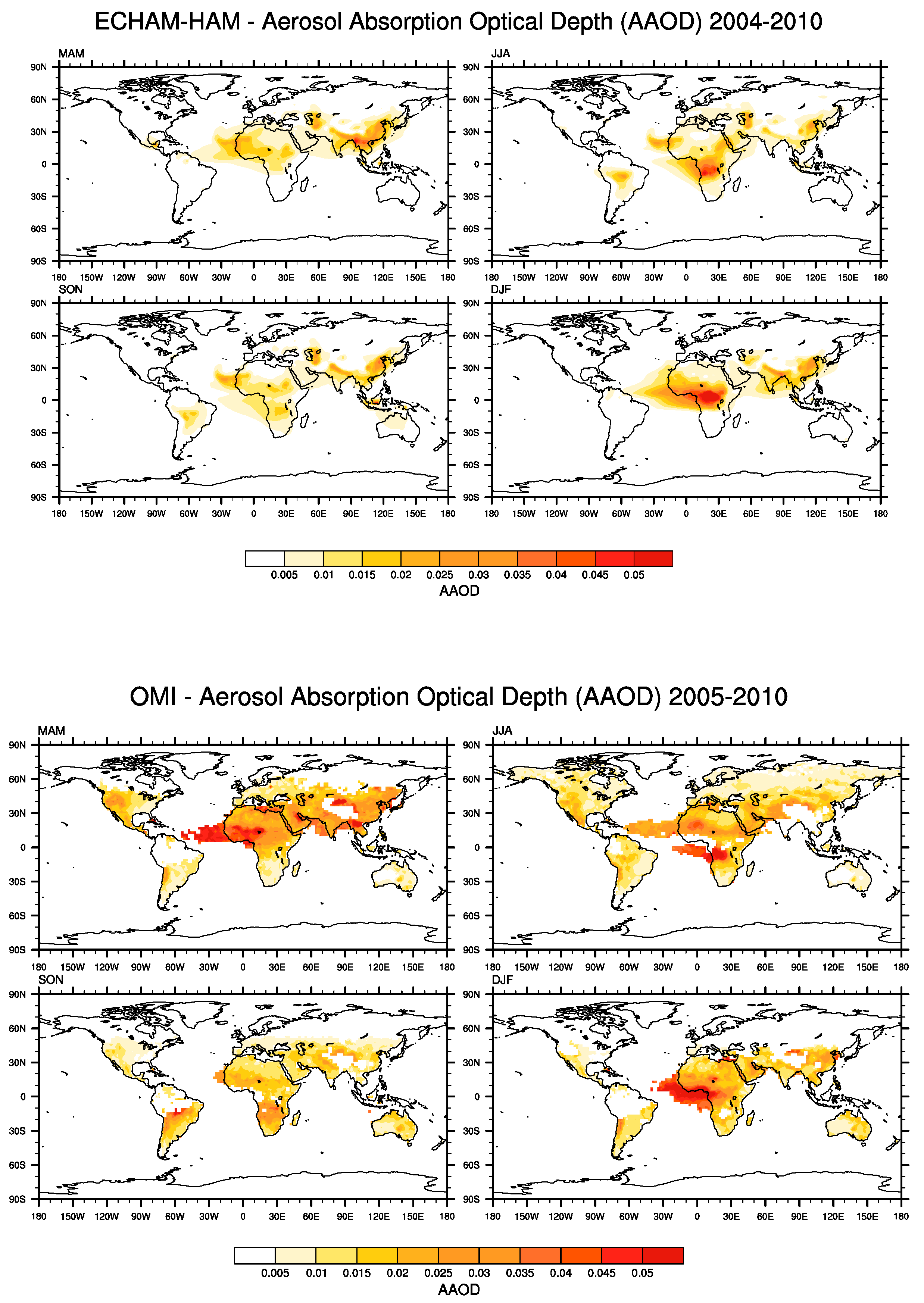

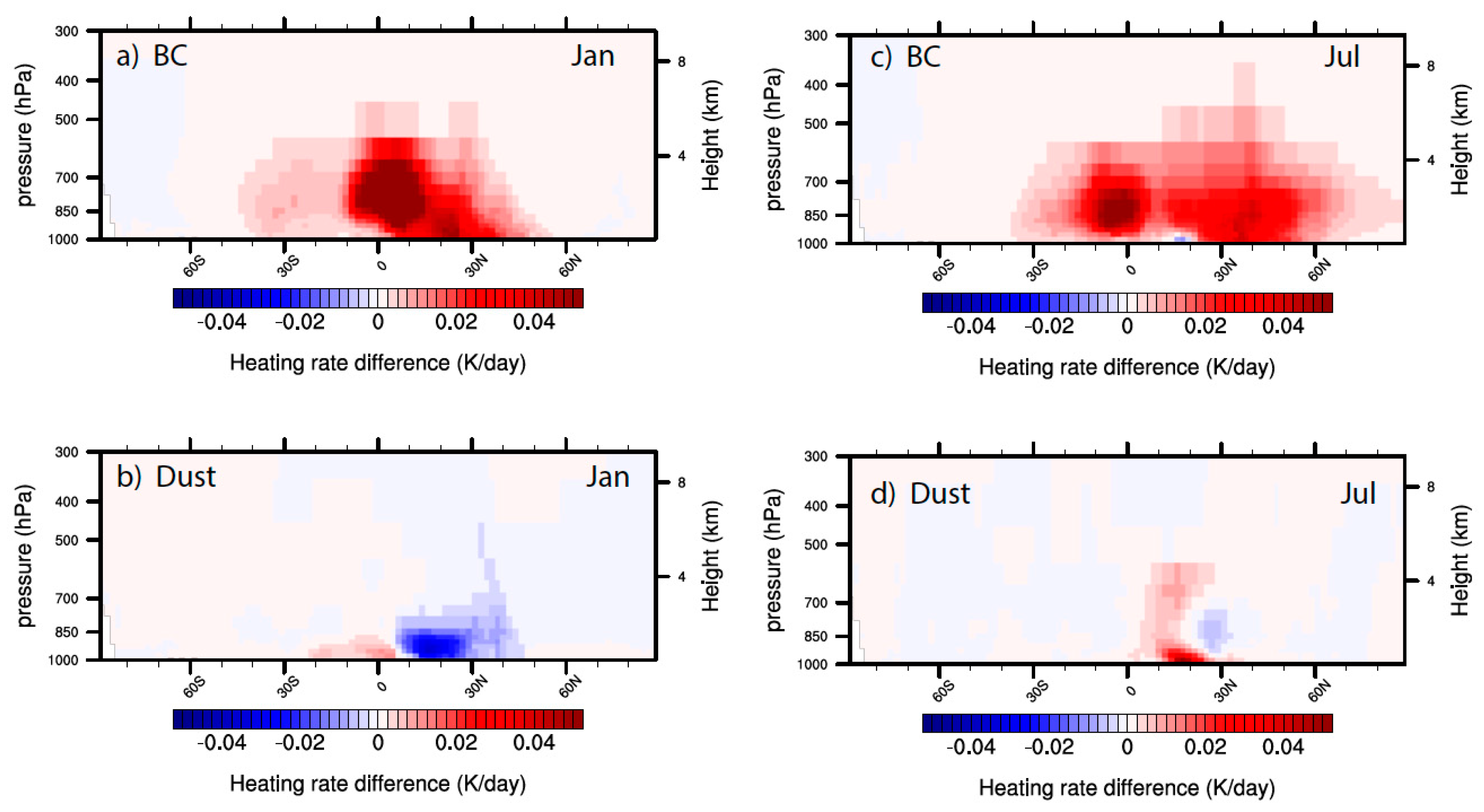
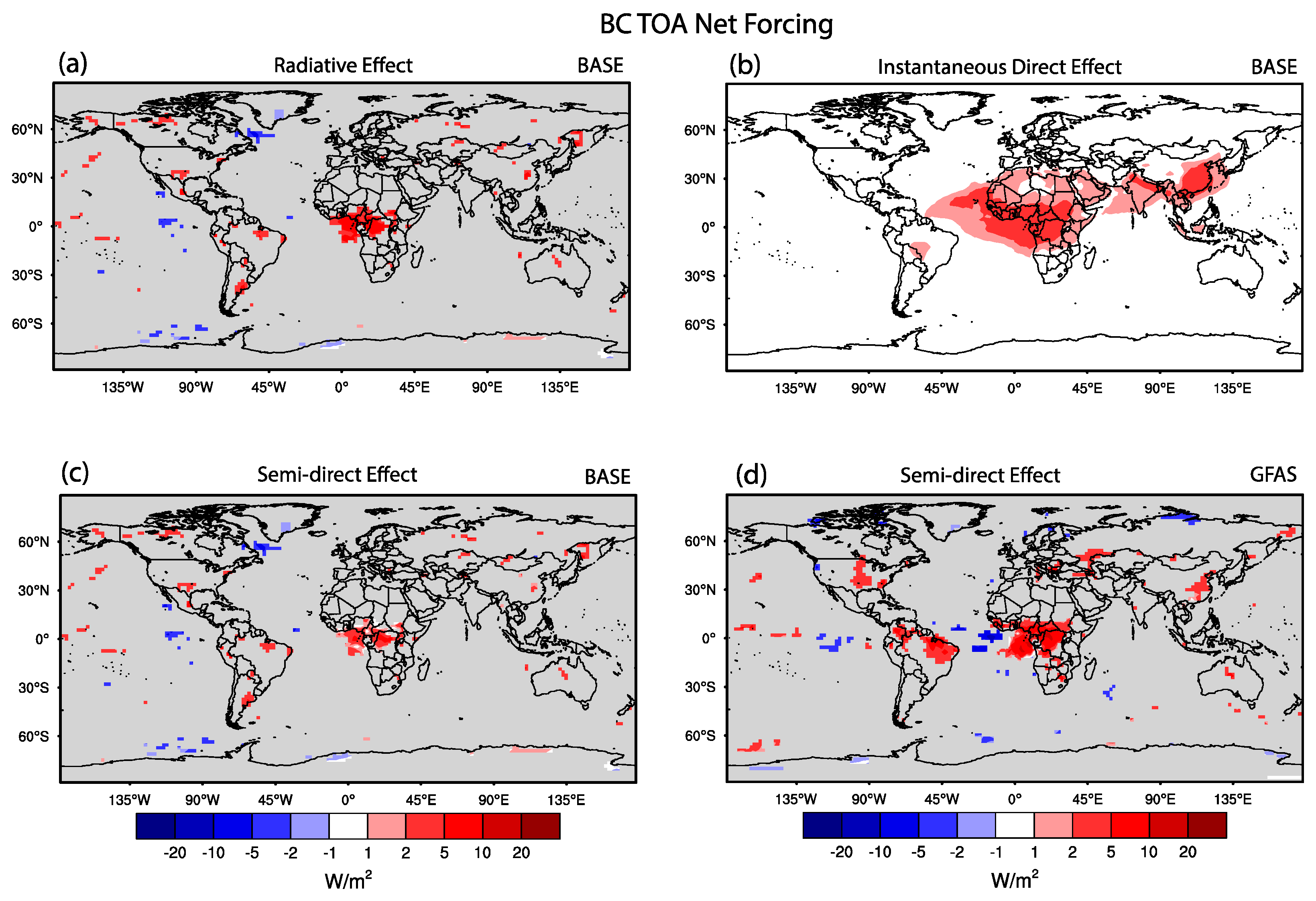
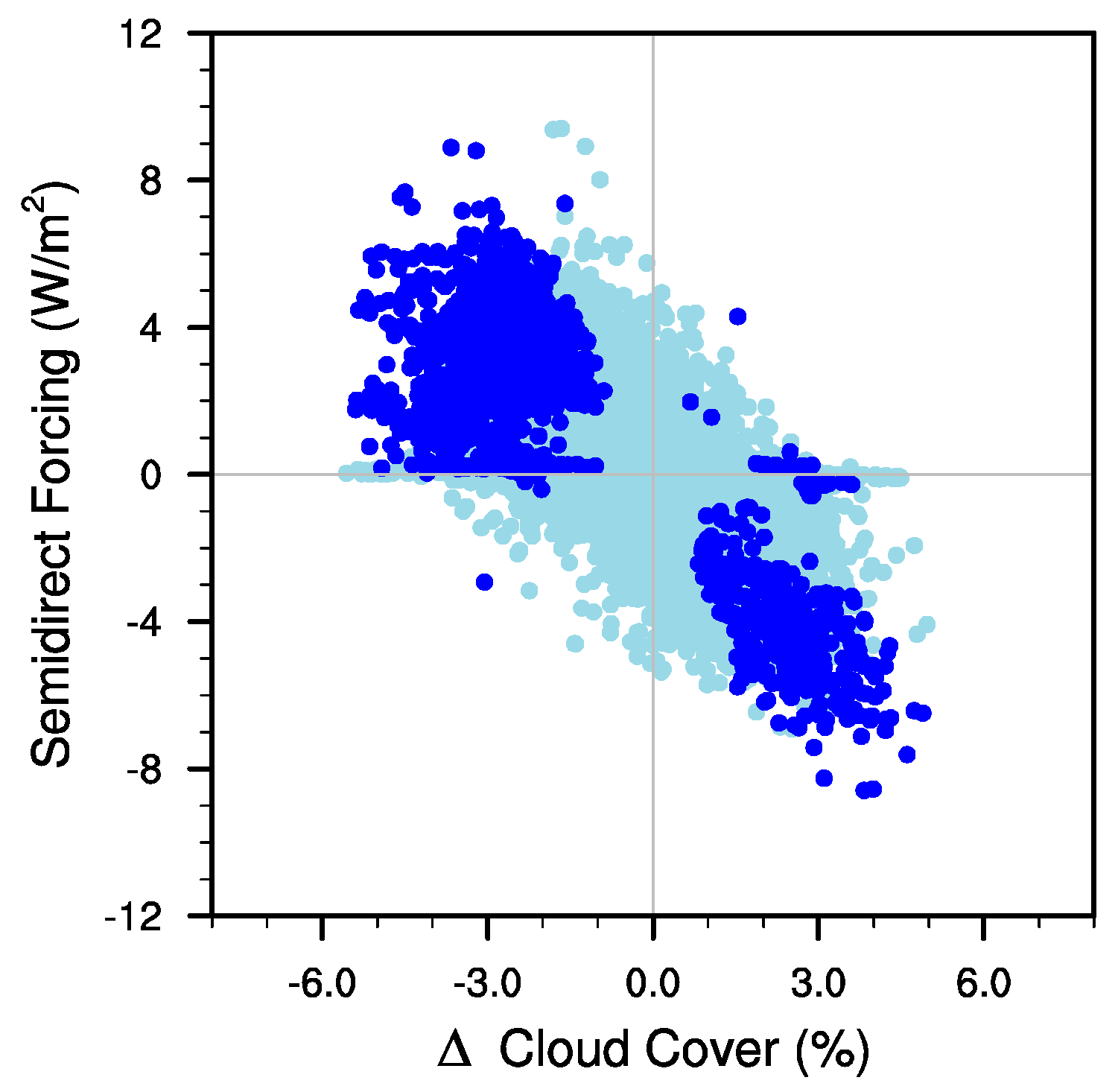
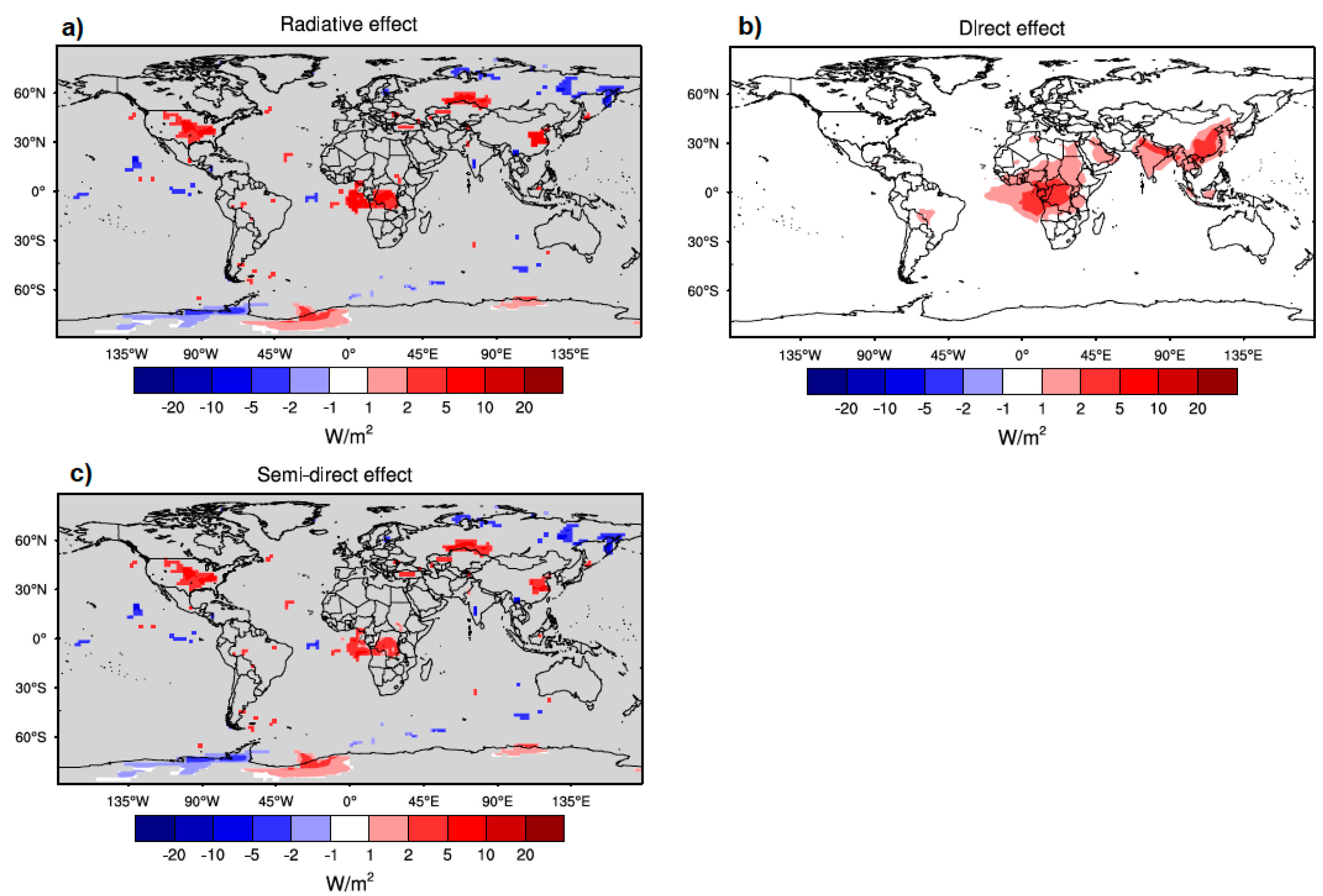
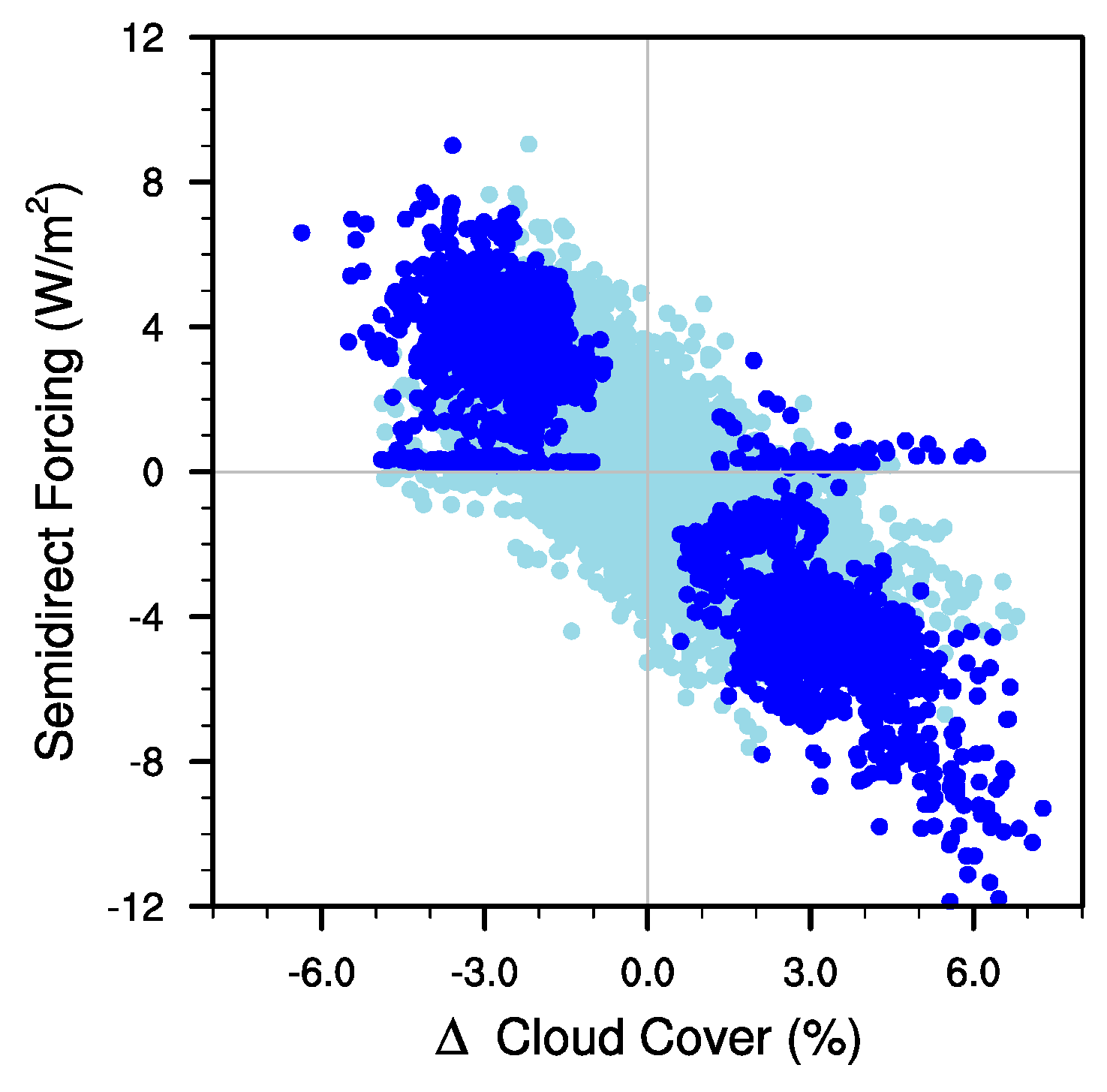
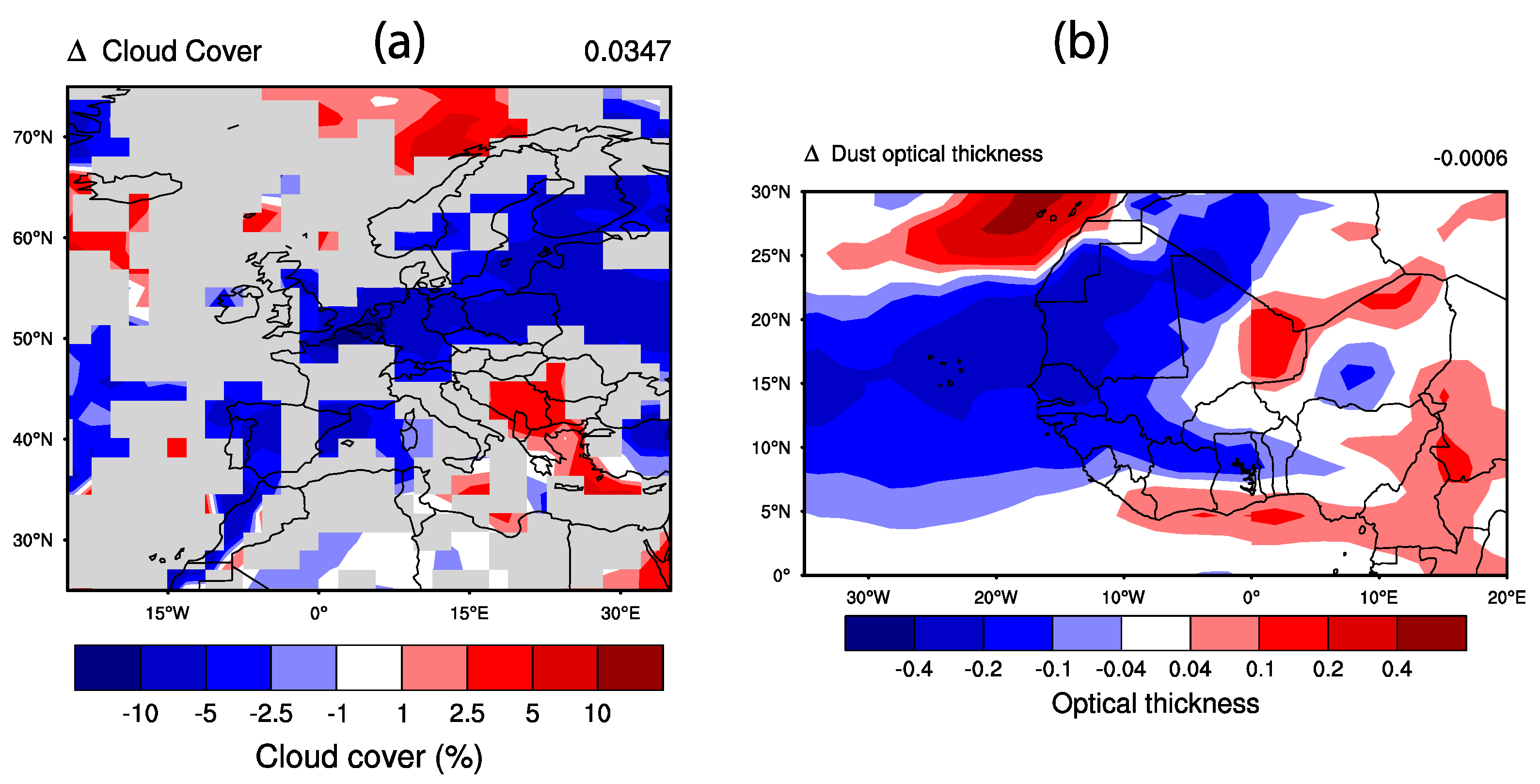
| Experiment | Aerosol Types | Aerosol-Radiation Interaction | Aerosol-Cloud Interaction |
|---|---|---|---|
| BASE | All | yes | no |
| GFAS | All | yes | no |
| noBC | no BC | yes | no |
| noABS | no BC, no dust | yes | no |
| noDust | No dust | yes | no |
| BASEind | all | yes | yes |
| noBCind | no BC | yes | yes |
| NoAer | all | no | no |
| Simulation | DRE | IDR | SDE (Net) | SDE (SW) | SDE (LW) | Cloud Cover |
|---|---|---|---|---|---|---|
| Wm−2 | Wm−2 | Wm−2 | Wm−2 | Wm−2 | % | |
| BASE−noAER | −1.13 (0.45) | −1.22 (0.05) | 0.08 (0.45) | 0.08 (0.57) | 0.01 (0.47) | −0.01 (0.40) |
| BASE−noBC | 0.51 (0.47) | 0.42 (0.06) | 0.09 (0.47) | 0.19 (0.58) | −0.10 (0.49) | −0.25 (0.41) |
| GFAS-noBC | 0.62 (0.46) | 0.36 (0.04) | 0.26 ((0.47) | 0.43 (0.58) | -0.16 (0.50) | -0.27 (0.10) |
| noDUST−noABS | 0.24 (0.46) | 0.27 (0.01) | −0.03 (0.46) | −0.03 (0.57) | 0.00 (0.50) | −0.08 (0.41) |
| BASEind−noBCind | 0.46 (0.47) | 0.41 (0.04) | −0.05 (0.47) | −0.16 (0.58) | −0.12 (0.49) | −0.12 (0.32) |
© 2018 by the authors. Licensee MDPI, Basel, Switzerland. This article is an open access article distributed under the terms and conditions of the Creative Commons Attribution (CC BY) license (http://creativecommons.org/licenses/by/4.0/).
Share and Cite
Tegen, I.; Heinold, B. Large-Scale Modeling of Absorbing Aerosols and Their Semi-Direct Effects. Atmosphere 2018, 9, 380. https://doi.org/10.3390/atmos9100380
Tegen I, Heinold B. Large-Scale Modeling of Absorbing Aerosols and Their Semi-Direct Effects. Atmosphere. 2018; 9(10):380. https://doi.org/10.3390/atmos9100380
Chicago/Turabian StyleTegen, Ina, and Bernd Heinold. 2018. "Large-Scale Modeling of Absorbing Aerosols and Their Semi-Direct Effects" Atmosphere 9, no. 10: 380. https://doi.org/10.3390/atmos9100380
APA StyleTegen, I., & Heinold, B. (2018). Large-Scale Modeling of Absorbing Aerosols and Their Semi-Direct Effects. Atmosphere, 9(10), 380. https://doi.org/10.3390/atmos9100380




